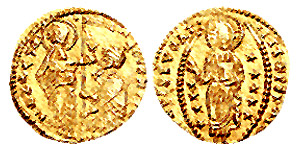 Above and beyond coins minted by Indian rulers, many foreign coins too were used in certain parts of India during different periods of history. Merchants and traders brought these foreign coins to India. During the early centuries of the Christian era, thousands of Roman gold and silver coins reached South India. It is believed that these coins were used as `money` or `currency` in places such as Muziris in Kerala and Madurai in Tamil Nadu.
Above and beyond coins minted by Indian rulers, many foreign coins too were used in certain parts of India during different periods of history. Merchants and traders brought these foreign coins to India. During the early centuries of the Christian era, thousands of Roman gold and silver coins reached South India. It is believed that these coins were used as `money` or `currency` in places such as Muziris in Kerala and Madurai in Tamil Nadu.
During the medieval period Venice in Italy traded with the ports of western and southern India. Marco Polo a Venetian trader many Venetian gold coins to India. These coins were issued by Venetian rulers such as Francis Lorendano, Paul Rainier and Peter Grimani.
The Venetian gold coins were known as ducats and sequins. They weigh around 3.5 grams. The obverse of these coins features the figures of St. Mark and the Doge or the chief magistrate or ruler. The reverse features Jesus Christ standing within an oval of stars.
The Venetian coins were in great demand, during the medieval period in Kerala. The Indian rulers purchased these coins for gifting them to priests and scholars. As these coins bore the figure of St. Mark, they were regarded as sacred objects by the Syrian Christians of Kerala. Many Syrian Christian women wore necklaces made of Venetian coins.
Venetian coins were also called Sanar kasu by some people of Kerala, because of the figure of Doge standing in front of St. Mark`s cross on these coins appeared like a toddy drawer {sanar) preparing to climb up the palmyra tree. The arches on the reverse of these coins resembled a bow or villu. Hence, these coins were also called villu kasu. The Indians even produced imitations of these Venetian coins. One such imitation coin bears the figures of the Hindu deities Rama and Sita on observe and Lakshmana on the reverse.






































